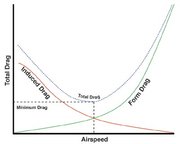Lift-to-drag ratio
|
|
In aerodynamics, the lift-to-drag ratio, or L/D ratio ("ell-over-dee", as opposed to "ell-dee"), is the amount of lift generated by a wing, compared to the drag it creates by moving through the air. A "better" L/D ratio is one of the major goals in wing design, since a particular aircraft's needed lift doesn't change, delivering that lift with lower drag leads directly to better fuel economy, climb performance and glide ratio.
The term is calculated for any particular speed by measuring the lift generated, then dividing by the drag it causes. These vary with speed, so the results are typically plotted on a 2D graph. In almost all cases the graph forms a U-shape, due to the two main components of drag on the wing.
Induced drag is caused by the generation of lift by the wing. Lift generated by a wing is directed straight up from the wing, but since wings typically fly at some small angle of attack, this means the force is directed both up and to the rear. The rearward component of this force is seen as drag. At low speeds an aircraft has to generate lift with a higher angle of attack, thereby leading to greater induced drag. This term dominates the low-speed side of the L/D graph, the left side of the U.
Profile drag is caused by air hitting the wing itself. This form of drag, simply another name for wind resistance, varies with the square of speed (see drag equation). For this reason profile drag is only a real factor at higher speeds, forming the right side of the L/D graph's U shape. Profile drag is lowered primarily by using thinner wings, but such a shape often leads to less low-speed lift, and thus higher induced drag.
It is the bottom point of the graph, the point where the combined drag is at its lowest, that the wing is performing at its best. For this reason designers will typically select a wing with its L/D peak at the chosen cruising speed of the aircraft, thereby maximizing economy. Like all things in aeronautical engineering, the lift-to-drag ratio is not the only consideration for wing design. Performance at high angle of attack and a gentle stall are often considered more important, and for this reason easy-to-fly wing designs like the Clark-Y continue to be used even though many more efficient wings have since been designed.
As the aircraft fuselage and control surfaces will also add drag it is fair to consider the L/D of the aircraft as a whole. As it turns out, the glide ratio, which is the ratio of an (unpowered) aircraft's descent to its forward motion, is exactly equal to the aircraft's L/D. This is especially of interest in the design and operation of high performance gliders (called sailplanes), which can have glide ratios approaching 50 to 1 (50 units of distance forward for each unit of descent) in the extreme cases, but with 30:1 being considered good performance for general recreational use. Achieving a sailplane's best L/D in practice requires precise and smooth operation of the controls.

